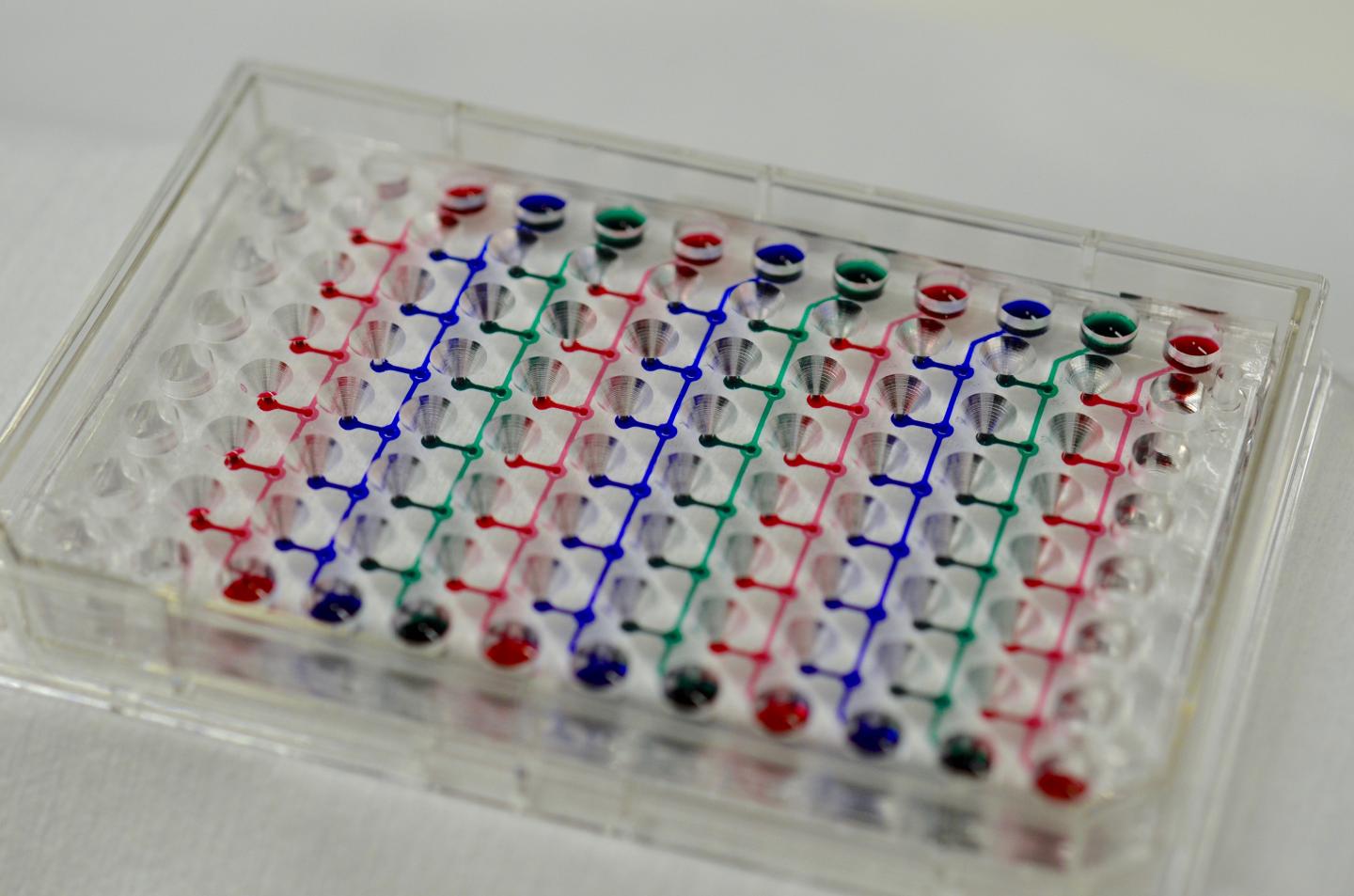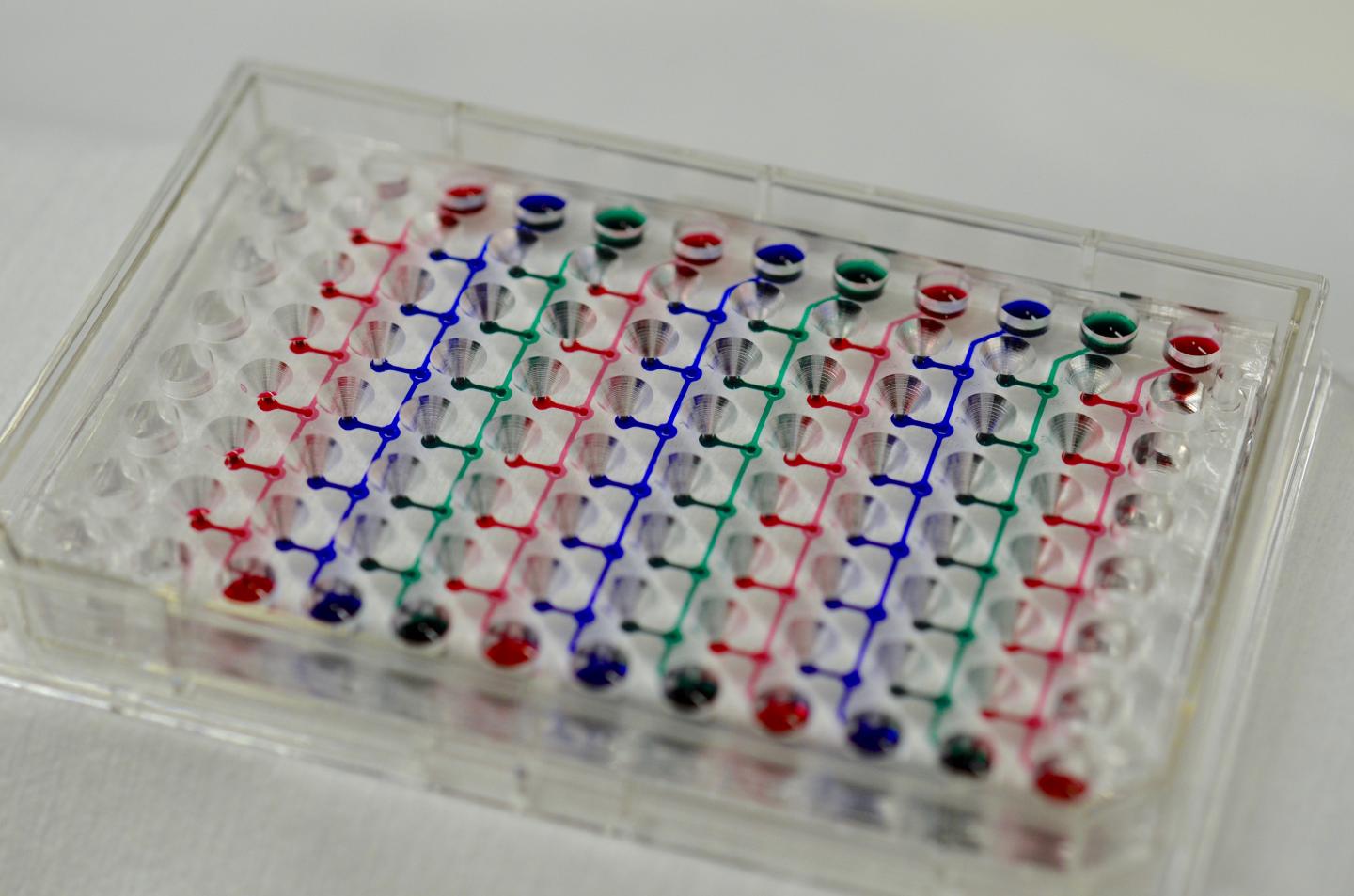
Credit: ETH Zurich / Olivier Frey
A team headed by scientists from the Department of Biosystems at ETH Zurich in Basel has developed a cell culture technology platform for testing interactions between chemical and pharmaceutical compounds and three-dimensional body tissue samples. While conventional cell culture experiments are performed using a two-dimensional cell layer in a petri dish, the new technology relies on a chip that accommodates small three-dimensional tissue spheroids that are barely half a millimetre in diameter.
"The three-dimensional microtissues better mimic organ tissue behaviour in a living body in comparison to conventional cell cultures and thus provide more meaningful results," says Olivier Frey, who is senior assistant in ETH Professor Andreas Hierlemann's lab and was largely responsible for developing the new method. Another unique feature of the new technology is that scientists are able to combine spheroids made from different tissues in one chip so that they can easily test compound interactions and impact on various tissue types.
More complex experiments now possible
More specifically, the new technology will allow scientists to test the efficacy of compounds to see, for example, whether a potential cancer drug inhibits the growth of tumour cells. By combining tumour and liver tissue in a single chip, researchers are additionally able to test whether the hepatic metabolism decreases or enhances the activity of the active agent, and whether the respective agent is toxic to the liver. In addition to testing drug candidates, it may also be possible to use the newly developed technology in personalised medicine.
In addition to combining cancer and liver tissues, which scientists have tested in their proof-of-concept study, other tissue combinations are conceivable. Researchers are now planning to work on a system including microtissues of organs affected by diabetes: pancreas and liver.
Prize for reducing animal experiments
In contrast to conventional cell culture experiments, the microtissue-based method is useful for providing more comprehensive answers to complex biomedical questions, many of which required animal experiments up to now. The technology offers the potential to reduce the number of animal experiments in biomedical research.
On 2 November, an international panel of experts therefore awarded the consortium around the ETH scientists the Global 3Rs Award/Europe, an international prize for research efforts to reduce animal experiments (see box). This is the second prize of this type that goes to the research group; in 2014 the group received an award from the UK-based National Centre for the Replacement, Refinement & Reduction of Animals in Research for an alternative system.
The body on a chip
The new technology was developed as part of an EU research project called "Body on a Chip", which was coordinated by the ETH spinoff Insphero and which involved other European project partners. The name "Body on a Chip" alludes to the term "Lab on a Chip", which describes miniaturised laboratory analysis platforms.
The main features of the cell culture chips developed by the ETH scientists include four (or six in the latest chip generation) wells in which tissue spheroids are placed and two reservoirs for the nutrient medium. A microchannel connects all wells and the reservoirs. Rocking or tilting motions of the chip or well plate slightly move the tissue spheroids and enable continuous perfusion and supply of nutrients and dosage of compounds.
The new technology is currently being used in a project supported by the Swiss Federation's Commission for Technology and Innovation (CTI) in collaboration with Insphero and the pharmaceutical company Roche. "If this test phase in industry is successful, it will be possible to think about marketing the device," says ETH professor Hierlemann.
[Box:]
The 3R principles
Efforts towards a more humane, ethical handling of laboratory animals are often subsumed under the term "3R". The three Rs stand for "replacement" (replacing animal testing with experiments that do not require animals), "reduction" (reducing the number of animals that are used for testing) and "refinement" (limiting the impact on the animals during a trial along with better experimental planning). More and more organisations on the national and international level are stepping forward to support these principles, including the Association for Assessment and Accreditation of Laboratory Animal Care International (AAALAC International), which confers the Global 3Rs Awards in cooperation with the International Consortium for Innovation and Quality in Pharmaceutical Development (IQ).
###
Reference
Kim JY, Fluri DA, Marchan R, Boonen K, Mohanty S, Singh P, Hammad S, Landuyt B, Hengstler JG, Kelm JM, Hierlemann A, Frey O: 3D spherical microtissues and microfluidic technology for multi-tissue experiments and analysis. Journal of Biotechnology 2015. 205: 24-35, doi: 10.1016/j.jbiotec.2015.01.003
Media Contact
Andreas Hierlemann
[email protected]
41-613-873-150
@ETH_en
http://www.ethz.ch/index_EN





